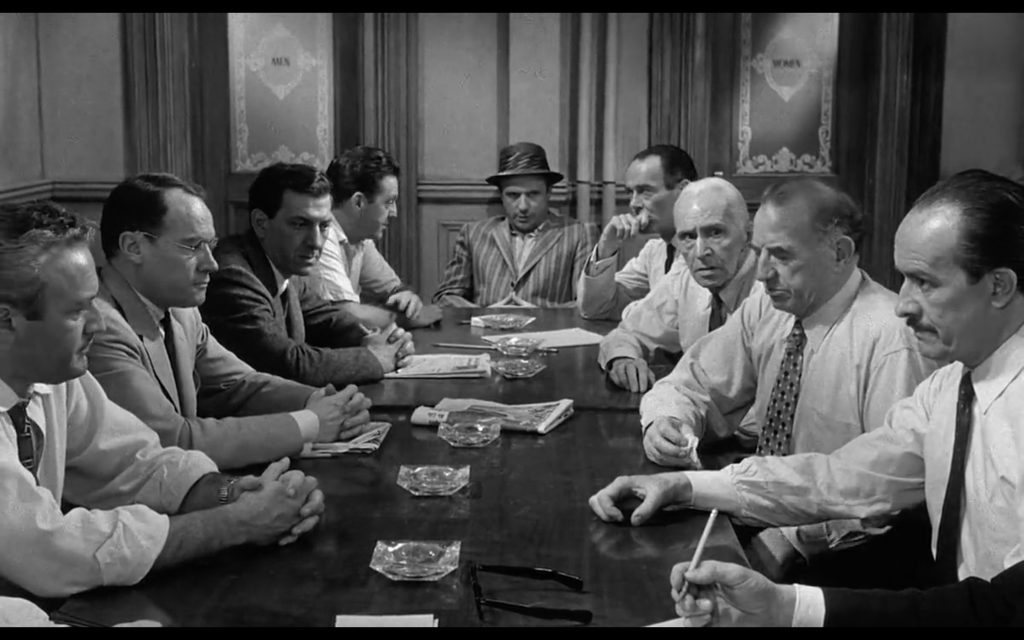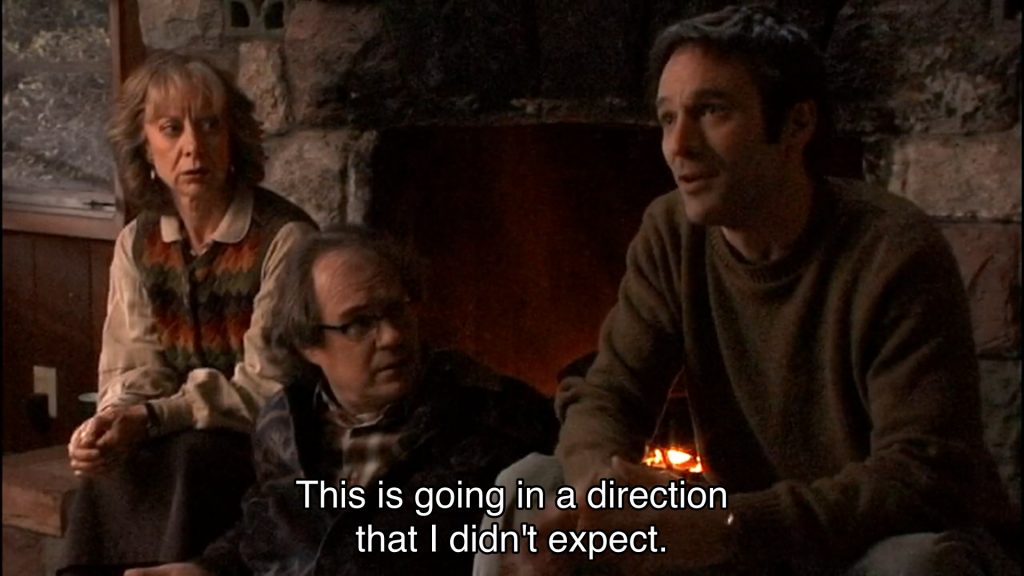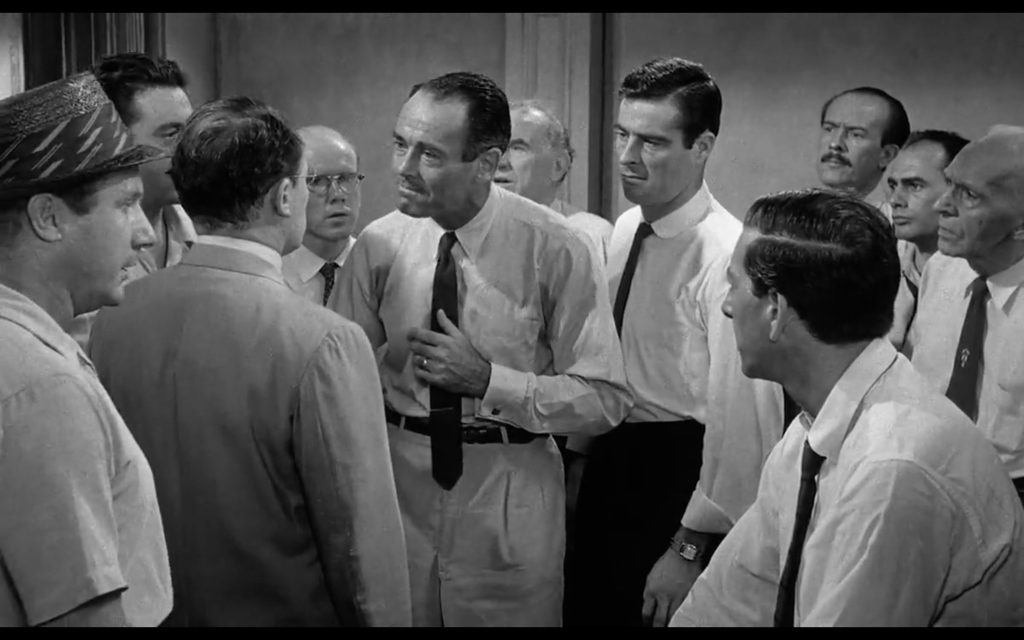At the Augmented & Virtual Reality roundtables at GDC 2015, there was consensus that moving a player through space made them uneasy. While in the future, I’m sure we’ll discover interesting tricks to ease the transition, what if we aren’t worried about that, and instead an entire interactive narrative experience happens in a single space?
This multi-part series examines inspirations for interactive narrative design in small spaces. These reviews are going to at times sound oddly mechanistic, as the goal is to focus on moments of potential narrative agency and player interaction. There is a separate movement towards Virtual Reality film, where one would semi-passively take in narrative in a virtual environment, but, as usual, I’m more interested in the interactive stuff.
In part of the series, let’s look at narratives that are one long conversation: 12 Angry Men, Circle, and The Man From Earth.

12 Angry Men is a well-known ensemble cast scene in the form of an argument between jury members discussing the guilt of the accused. Initially, all except one jury member thinks the accused is guilty, but the one dissenter brings the rest around until the unanimous verdict is not guilty. The setting is a single room, all 12 members around a large board table, while some side conversations happen in the adjacent bathroom. The time of day is mid-afternoon on “the hottest day of the year”, and the temperature continually rises during the play. I reviewed the 1957 movie, but this production had an interesting history, with its first iteration being a live teleplay on CBS in 1954. Only later was 12 Angry Men adapted for the stage, and then a movie.

In Circle, 50 people, unknown to each other, wake up in a dark room, each stuck in a red outline on the floor. Every two minutes, someone is killed by an energy emanating from a dark sphere in the centre. The group discovers they can mentally and anonymously vote for who dies next. They quickly reach a consensus to initially vote for the older people first, which buys them time to try to figure out what is happening. In this game of artificial scarcity, people must convince each other of their self-worth as their number is reduced from 50 to 1.

A professor has several of his friends show up at his house as he’s packing up to move on from his career to another stage of his life. On a whim, he tells them that he’s a Cro-Magnon, and has been alive for 14,000 years, moving from life to life so people don’t notice his immortality. He’s encountered many historical figures, and even been a few historical figures. The entire conversation takes place in his living room, with some brief moments outside. He initially poses his immortality as a hypothetical, which his academic friends eagerly take up as a thought experiment. When he tells them he actually is 14,000 years old, many get offended, but are eager to continue the conversation. To ease tension at the end, he tells them it was all a joke, though events at the end of the movie make it clear it was not.
TALKING POINTS:
All of these conversations take place in real time without major time jumps. The setting shows gradual progression of time. In 12 Angry Men, it starts hot and gets hotter. In The Man From Earth, the sun is setting and it gets darker and colder, while people crowd closer to the fireplace. In Circle, the setting is artificial constant; however, frames of the film start packed with people, and as people are killed off, frames are mostly filled with black negative space. 12 Angry Men particularly feels like a claustrophobic pressure cooker. The focal length is actually slowly reduced over the course of the film. In a Virtual Reality setting, similar effects over an hour could occur by having the set slowly shrink, or the lighting slowly change angle or colour.
“Show don’t tell” is a common maxim in storytelling. The settings for all these films are mundane; a board room, a living room with a fireplace, an dark room with red markings on the floor. Each of these films features every character giving rich narrations, of what happened in the court room (12 Angry Men) of his meeting with the Buddha (The Man From Earth), or of their dubiously honest biographies (Circle). There are long shots in each film of just a character’s face, speaking. I am constantly impressed with how engrossing these movies are, where if you get slightly distracted, you miss a really rich description. This is a surprising contrast to “show don’t tell”. Are these just well-written movies? Maybe. In 12 Angry Men, and Circle, the characters are captive, whereas in The Man From Earth, characters describe themselves as “trapped by the story”.

“Stage business” is a term for incidental physical activities that actors can do to occupy their hands, express their character, or maintain physical interest. The Man From Earth has the most stage business; the professor’s friends show up with assorted picnic-like food. Later, they serve whiskey and get closer to the fireplace, surrounding themselves with blankets and sweaters. In the middle of the movie, furniture movers show up to take all the couches and tables to the thrift store. For several minutes, all the characters need to stand up and walk around to avoid the movers, before settling back on the floor as the professor’s story continues. In 12 Angry Men, a prop floor plan showing the apartment where the murder took place is briefly taken out, and they adjourn for a bathroom break, where there are a few one-on-one conversations in the bathroom as jurors try to convince others to their side. Jurors are continually wiping sweat from the heat off themselves. Jurors use body language heavily to represent their opinions, leaning forward or backwards, or moving to the side of the table of people they agree with; they can also leave the table to lean against the wall or stare out the window. In one quietly intense scene, as one juror is monologuing, every other juror slowly turns to face away from him, to show they disagree.

All that people can bring is their individual perspectives, and impressions based on their appearance. In The Man From Earth, every character is an academic, which sort of makes it feel like a Robert J. Sawyer novel. They call out how perfect of a group it is to judge his story, a biblical literalist, a medical doctor, a philosopher, an anthropologist, a psychologist, and archeologist. One of the characters has a clearly faltering body and is dying of poor health and old age. He accuses the main character of possibly stealing everyone else’s life force. In Circle, everyone is judged first by their appearance, and later how much of a story they can muster up for why they shouldn’t have to die. Then they find out someone has had cancer, and debate killing her next. Turns out one guy only speaks Spanish and someone quickly decides that they might as well kill him since they can’t talk. They decide a while back that a pregnant mother and her other child (the only one in the group) will probably tie for last, which means one of them will have to kill the other, which is traumatic, so they determine they should make a choice between them earlier.

In 12 Angry Men, by stark contrast everyone is very similar in appearance: older-than-middle-age average-looking white professional men who live in New York wearing business clothes. You could assume this was the nature of casting in the 50s, but it becomes interesting how diverse the perspectives and opinions are, given that everyone starts looking similar. From these tiny differences, erupt a diversity of viewpoints. Some characters are loud, and grab your attention, which makes it more interesting when a quiet character gets their turn for your attention. A surprising theme in this movie is the abject hatred of poor people for being poor. The cast is entirely white, including the boy on trial, and if this movie was filmed in a later era, I suspect there would be tense moments across race lines as well, but the underlying feeling of many on the jury is that poor people are bad for people poor, and probably criminals. Sports are still a metaphor for manly man American relationships.
Stray Notes:
– The Man From Earth would be a great LARP. Come up with an absurd claim about yourself, and then try to defend it in front of close friends. Similar to the game Two Truths and a Lie.
– 12 Angry Men still has a “star”, Henry Fonda. The camera focuses a lot on him, and he seems inexplicably competent in expressing himself, like a distracting Mary Sue.
– In Circle, they briefly develop a theory that maybe they are all on trial and are supposed to judge each other. You could possibly implement this in a multi-user vote-off Chatroulette format.
– In The Man From Earth, he introduces his crazy claim as a hypothetical first. He says “What would it look like if a Cro-Magnon managed to live to present day?” They discuss this for 20 minutes or so before he says “I am immortal”. I think this is a great demonstration of how to convince people of seemingly implausible facts.